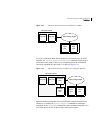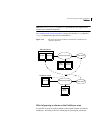
75Understanding Veritas Volume Manager
Hot-relocation
association. However, in such a case, you can use the vxplex snapback
command with the
-f (force) option to perform the snapback.
Note: This restriction only applies to traditional snapshots. It does not apply to
instant snapshots.
■ Any operation that changes the layout of a replica volume can mark the
FastResync change map for that snapshot “dirty” and require a full
resynchronization during snapback. Operations that cause this include
subdisk split, subdisk move, and online relayout of the replica. It is safe to
perform these operations after the snapshot is completed. For more
information, see the vxvol (1M), vxassist (1M), and vxplex (1M) manual
pages.
Hot-relocation
Note: You need a full license to use this feature.
Hot-relocation is a feature that allows a system to react automatically to I/O
failures on redundant objects (mirrored or RAID-5 volumes) in VxVM and
restore redundancy and access to those objects. VxVM detects I/O failures on
objects and relocates the affected subdisks. The subdisks are relocated to disks
designated as spare disks and/or free space within the disk group. VxVM then
reconstructs the objects that existed before the failure and makes them
accessible again.
When a partial disk failure occurs (that is, a failure affecting only some subdisks
on a disk), redundant data on the failed portion of the disk is relocated. Existing
volumes on the unaffected portions of the disk remain accessible. For further
details, see “Administering hot-relocation” on page 379.
Volume sets
Note: You need a full license to use this feature.
Volume sets are an enhancement to VxVM that allow several volumes to be
represented by a single logical object. All I/O from and to the underlying
volumes is directed via the I/O interfaces of the volume set. The volume set
feature supports the multi-volume enhancement to Veritas File System (VxFS).
This feature allows file systems to make best use of the different performance


















